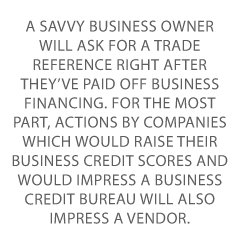Building corporate credit is more than just the objective information. It’s also about the subjective. So sit tight, because here are detailed things you should know about trade references. And you’ll find out how to fill out a trade reference form.
1. What are Trade Credit References, Anyway?
Here is a standard trade reference meaning. Trade references on an application are used to help lenders and business to business suppliers make decisions about whether or not to extend credit to a credit applicant.
So, what are trade references on an application? They are one of the only parts of a credit file that isn’t just numbers or court filings!
These credit references for businesses are usually presented in conjunction with a formal file. Such a formal credit report would come from a known business credit-rating agency. These are the best-known CRAs, such as Experian or Dun & Bradstreet.
Companies and banks which loan money and extend credit and financing (like a credit line) want to be sure that their customers can pay their debts on time and in full.
Excellent trade references are an important asset which successful companies should place a high value on.
So a trade reference means there is more to go on that numbers. With trade references on credit applications, there is a lot more detail.
2. Criteria for Asking for and Getting a Business Trade Reference Letter
A small business is a lot more likely to get good trade references if they have a good payment history with the company they are asking for the reference from. This will have to be a supplier where you have net terms, e.g. net 30.
You will do best if you have some time as a customer with the company where you are requesting a reference. If you just started doing business with them last week, there are probably not enough transactions for you to ask.
But if you have put in a good year with them, and maybe even six months, a supplier should have a more complete trade credit experience and payment experience, and a fuller credit profile to consider when writing you a trade reference.
A supplier will then be able to intelligently speak to whether you’ve paid your business credit card bills with them on time. Business credit bureaus will be more interested in a positive trade reference from a vendor where you have a higher credit limit, too.
Lenders and credit suppliers will often ask just how long an account has been open. They will ask about its credit or purchasing limit. And they also want to know how many times (if any) the amount due has been paid late. Is a business’s credit management any good?
Such inquiries can come either by telephone or in writing.
Creditors naturally place a higher value on customers with a longstanding payment history and several transactions. So they often will save their best deals for credit applicants with the best trade references and credit profiles.
3. A Trade Credit Reference Can Provide an Accurate and Correct Picture
Some banks may not report defaults to the big national credit bureaus (Experian, Equifax, and Dun & Bradstreet) until the borrower is 30 or 60 days late.
And some suppliers, in particular smaller businesses, will not report their client histories at all. These factors make checking trade references vital when companies are making the decision to extend credit and financing.
In addition, month to month payments will always represent a far more accurate picture of a small business’s true financial viability. This is because even companies with good cash flow could be taking unreasonable risks at the expense of their suppliers.
Here is where a business trade reference can really help your business.
4. Bank and Trade References Showcase Timely Paying and Repayment
Most businesses realize that maintaining a prime credit rating is very important. Therefore, if they start struggling, they may become good at prioritizing their debt and supplier payments.
This is like the old expression, ‘robbing Peter to pay Paul’. By using their cash flow to pay any bank loans and larger suppliers, they might also be putting off smaller creditors. In this way, these businesses on the edge can paint a misleading credit portrait.
Therefore, it is important to start checking both large and small business trade references. As a result, you can save yourself the time and headaches of taking on new clients whose accounts have a high chance of going into collections.
This is true of both companies looking to extend credit, and banks looking to make loans. And for new businesses, this is really vital. It helps a lot to get trade references for new business.
5. What Are the Number and Sort of Trade References a Business Can Get?
A standard business credit application will ask for three trade references. So, these are often creditors and suppliers within the industry. A good trade reference example tends not to be utilities like telephone and gas service.
This is because many struggling businesses may try to put off their suppliers for a month or two. But they don’t do this with utility companies. At least, they won’t do this if they want their offices to have heat and lights.
Primary and direct references, which include suppliers of items such as computer equipment and raw materials, will be the most valuable.
Secondary trade references may include subcontractors who may be willing to not be paid until the main client pays. As a result, these examples of credit references can be less reliable indicators of a small business’s overall financial health.
Still, you should take any negative feedback on a trade reference sheet seriously.
Trade Reference Examples
Any standard trade reference will generally contain the following details:
- A customer’s basic contact details from your credit profile with them (like business name, etc.)
- Credit limit
- Past due balance (for any late payment at all)
- Any business loan info
- Credit terms
- Date account opened
- Open AR balance (accounts receivable)
- Highest previous balance
- DBT (days beyond terms) – current and previous
- Number of credit transactions
Fortunately, you do not need to have a good personal credit score in order to get a trade reference. This is because personal credit really isn’t a factor. Although personal credit can be a factor in a vendor deciding whether to do business with your company at all.
Even a commercial credit reporting agency that uses personal credit to calculate business credit (such as Experian) will be more interested in your financial relationship with a vendor posting a trade reference.
Since payment history matters, a very new startup will be at a disadvantage. But they can offset that with on-time payments. This can also help them build a good business credit score more quickly.
 A savvy business owner will ask for a trade reference right after they’ve paid off business financing. For the most part, actions by companies which would raise their business credit scores and would impress a business credit bureau will also impress a vendor.
A savvy business owner will ask for a trade reference right after they’ve paid off business financing. For the most part, actions by companies which would raise their business credit scores and would impress a business credit bureau will also impress a vendor.
Bonus #1: How to Make a Trade Reference Request if You Are the Creditor Asking About a Company You Do Business With
So, a trade reference sample is best. This great business credit reference form came from Business Debt Line. Make sure to fill in the blanks or information in square brackets []. It also rather neatly answers the question: what questions should I ask a trade reference?
Trade Reference Template: Sample Trade Reference Letter for a Creditor
From:
__________ [Sender’s name]
__________ [Sender’s address]
__________
__________
Date: __________ [Sender wrote the letter on this date]
To:
__________ [Receiver’s name]
__________ [Receiver’s address]
__________
__________
Dear Sir/Madam:
Re: [enter the name of the company you are asking about here]
I have received an application for a credit account from the above named company. Your name has been given as a referee. Therefore, I would be grateful if you could answer the following questions.
How long has the customer traded with you? ________________________________
What are your terms of payment? _______________ days
Does the customer generally pay within the time required? YES/NO
Would you consider the customer to be a good credit risk? YES/NO
Please add any other comments you feel are relevant below.
_________________________________________________________________
_________________________________________________________________
_________________________________________________________________
Once you have completed this form please return it in the envelope provided.
Thank you for your assistance.
Yours faithfully,
Signature
Name
For and On Behalf of Your Business
Bonus #2: How to Ask for a Business Trade Reference if You Need a Trade Reference for Your Company
Let’s use another business credit sample. Make sure to fill in the blanks or information in square brackets [], and select anything with a slash (/) and delete the other choice.
So, this is a great business reference request template. It includes some great questions to ask when checking a business credit report.
Sample Trade Company Reference Template (Trade Credit Request Letter for Company)
{This one helps to answer questions to ask when checking trade references}
From:
__________ [Sender’s name]
__________ [Sender’s address]
__________
__________
Date: __________ [Sender wrote the letter on this date]
To:
__________ [Receiver’s name]
__________ [Receiver’s address]
__________
__________
Dear Sir/Madam:
Re: Trade Reference for [your company]
It has been [your company]’s pleasure to conduct business with you for [number] years/months. The company is applying for more credit, and I hope to be able to cite your name as a referee. Would that be possible? Please let me know either way.
If the answer is yes, then I have prepared a few brief questions. Please send it back in the enclosed envelope and we will type it up. We will send it back with another self-addressed, stamped envelope, so you can send us a signed copy.
Of course we will enclose a copy for you to keep for your records.
Therefore, I would be grateful if you could answer the following questions.
How long has [your company] traded with you? ________________________________
What are your terms of payment? _______________ days
Does [your company] generally pay within the time required? YES/NO
Would you consider [your company] to be a good credit risk? YES/NO
Please add any other comments you feel are relevant below.
_________________________________________________________________
_________________________________________________________________
_________________________________________________________________
Once you have completed this form please return it in the envelope provided.
Thank you for your assistance.
Yours faithfully,
Signature
Name
For and On Behalf of Your Business
Bonus #3: How to Write a Trade Reference About a Company You Do Business With
So, let’s start with a trade reference example. Make sure to fill in the blanks or information in square brackets [], and select anything with a slash (/) and delete the other choice in this trade reference form.
It neatly answers the question: how do you give a trade reference?
Sample Trade Reference Letter
From:
__________ [Sender’s name]
__________ [Sender’s address]
__________
__________
Date: __________ [Sender wrote the letter on this date]
To:
__________ [Receiver’s name]
__________ [Receiver’s address]
__________
__________
Subject: Trade Reference for [company name]
Dear Sir/Madam:
Thank you for requesting a trade reference. We have done business with the [company name] for [amount of time]. Our terms of payment with them are [number] days.
[Company name] generally pays/does not pay within the time required.
Payment patterns with [company name] are/are not subject to seasonal fluctuations. I would/would not consider the customer to be a good credit risk.
If you have any questions, please feel free to contact me.
Yours faithfully,
Signature
Name
Business Name
Bonus #4: What to Do with a Trade Reference Request About Your Company
Now, you can send a copy of your trade reference to Dun & Bradstreet here. So, it will become part of your credit file, available to anyone who pulls your report. Because CRAs such as D&B give trade references meaning.
You can also add trade references to a CreditSafe profile.
Things You Should Know About Trade References: Takeaways
So, what are trade references? Trade references for a small business can provide a much clearer picture of the overall health and day to day operations of a company. So, these allow a credit or loan provider to dig much deeper into the financial guts of a company.
You may still want to know, what if I don’t have a trade reference? So, what is a trade reference on a credit application? This is the best way to get to the real truth about the business’s Fundability. Trade and bank references can help businesses get capital.

